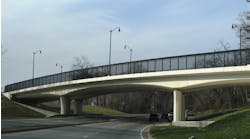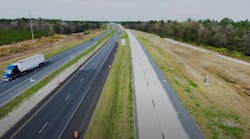When the Texas Department of Transportation (TxDOT) and the city of Fort Worth decided to replace the 99-year-old West Seventh Street Bridge over the Trinity River, they had two main priorities: Construct a signature bridge the community would be proud of and minimize disruption to the popular thoroughfare, which links the city’s downtown commercial district with a burgeoning cultural arts neighborhood. They also were looking for a great value.
“With significant public involvement, TxDOT and the city were able to work out a partnership that met the high expectations of the business community and historic groups,” said George Behmanesh, the city of Fort Worth’s assistant director of transportation and public works.
That partnership resulted in TxDOT’s Fort Worth District Engineer Maribel Chavez and TxDOT Engineer Dean Van Landuyt submitting a design for the world’s first precast network arch bridge. The plan satisfied stakeholders’ desire for an attractive, affordable structure and proposed a procedure to reduce the bridge closure to a minimum of six months. Sundt Construction Inc.’s San Antonio, Texas, office was hired and charged with working closely with TxDOT to meet these expectations.
“We are very excited the community supported this design and construction process,” said Chavez. “And, Sundt has been an exceptional partner to deliver this complex project with the right expertise and sensitivity to the community’s needs.”
Done elsewhere
The majority of the work on the new $25.9 million West Seventh Street Bridge is taking place off-site, allowing the original bridge to remain open and operational during the bulk of the two-year project. When the time comes to actually start erecting the replacement structure over the Trinity River this summer, the old bridge will be closed and demolished and the new bridge will be built in its place—in just 150 calendar days.
It’s a schedule Sundt Area Manager Chris Cedar said is “tight, but doable.” The new bridge, which has been in off-site construction since January 2012, is expected to be open to traffic by November, if not sooner.
Already, Sundt’s own concrete crews have been at work for nearly a year fabricating the 12 precast, post-tensioned arches that will run the length of the 980-ft-long structure. The signature design by TxDOT also includes four traffic lanes, a center-raised median and 10-ft-wide separated paths on the outside of the bridge for pedestrians and cyclists.
In order to minimize disruption at the project site, the arches are being cast in a yard about four blocks away from the existing bridge. Each arch weighs about 590,000 lb and rises more than 20 ft above the roadway surface at its highest point. The arches are cast while lying flat on their sides, then post-tensioned and installed with stainless steel rods that run from the top of the arch to the tie. After they cure to a concrete strength of 6,000 psi, the arches are rotated into a vertical position and shifted into storage for up to 40 weeks. Each arch takes about four weeks to complete.
Arch crossing
Community excitement is growing as the bridge elements come together in the casting yard. TxDOT and Sundt have encouraged community members to witness the unusual construction process by offering tours as a way to educate and inform the public about how their tax dollars are being spent.
Starting in February, bridge traffic will be reduced to one lane as crews begin on-site construction. At that time, overhangs will be removed and new columns will be erected. Once that step is completed, Columbus, Miss.-based Burkhalter will load the arches—each one measuring 163 ft from end to end—onto self-propelled modular transport trailers using wing dollies and haul them at night over the existing bridge to new foundations located alongside the original structure. This phase of the project, including transporting the arches and setting them in place, is expected to take approximately one month to complete.
“What makes this project unusual is the fact that these arches are so enormous and that we’re casting them, post-tensioning them and then setting them in place,” said Cedar. “It’s not done very often, if at all.”
The existing bridge will be closed to traffic this summer as the old bridge is demolished and construction of the new bridge’s floor beams, panels and slab are completed through the fall.
Cedar said the project is extremely complex, not only from a construction perspective, but from a logistical standpoint, too.
For starters, there’s the challenge of how to handle and store the massive arches until crews are ready to move them to the bridge construction site.
“Arches are not built to lie on their sides; you have to support them just right to pick them up and rotate them,” Cedar said.
Transporting a dozen 590,000-lb arches through the streets of Fort Worth on a platform trailer is tricky as well—even if it is only a four-block trip.
“There has been a lot of planning the route to get down there to avoid crossing or running down major power lines and water lines and other utilities,” he said. “There’s too much weight for the existing utilities. There’s also the challenge of moving a huge member across a very old bridge—it takes significant engineering to figure out.”
Engineers also have been busy calculating how the trailers will negotiate the 90° turn located on the route between the fabrication yard and the bridge site and how to move within the city’s height restrictions.
Sundt’s Virtual Design and Construction (VDC) BIM models are helping the team manage the project’s construction complexities, particularly the fabrication of the arches, because they contain many structural and lighting elements that have the potential to clash with one another if not planned precisely. Using multidimensional computer models, the team has been able to verify TxDOT’s design and identify a few minor conflicts prior to construction.
“VDC has helped keep us on schedule because we’re not trying to fix things as we’re building the arches,” Cedar said. “It has helped us realize the sequence of what needed to go inside the arch at the proper time. It’s very congested inside there, with cooling tubes to control the concrete temperatures after we place the arches, along with other elements. We’re also using LEAN to help us in the planning process, which is not something a lot of civil constructors do.”
Approximately 218,000 lb of polished stainless steel within the arches will be illuminated at night with embedded lighting, making this West Seventh Street bridge a one-of-a-kind structure.
Cedar said in addition to coordinating storage, transportation and construction details for the massive arches, there also has been a significant amount of coordination taking place between TxDOT and Sundt personnel to ensure the project is completed within the 150-day window. The contractor stands to benefit significantly from a financial incentive to open the new bridge before the holiday shopping season begins in late November. Crews will remain on-site through January 2014 as they wrap up final work under the new structure.
Currently about 15 Sundt team members are working on the project; that number is expected to swell to around 70 workers during the bridge-rebuilding stage.
“Partnering has been a major part of this project, which has very high visibility in the community,” Cedar said. “The collaborative environment with TxDOT on various levels and divisions has been very important to the success of this job. Everyone is trying to do what’s right for the project. The leave-your-company-name-tag-at-the-door attitude has been great. It’s all about the job.”
John Carlson, senior vice president and Texas district manager for Sundt, said the West Seventh Street Bridge project has been a good match for the contractor’s extensive experience and skill set in the area of government projects on a national level. He applauds the state of Texas for its commitment to rehabilitating older bridges and its desire to create a landmark gateway between two significant areas of Fort Worth that will improve the city’s skyline and endure for future generations.
“Developing innovative ways to build complex projects is one of Sundt’s specialties,” he said. “This project is a great example of putting that experience to work on a high-visibility structure that is making a significant impact on a large group of stakeholders.” R&B


